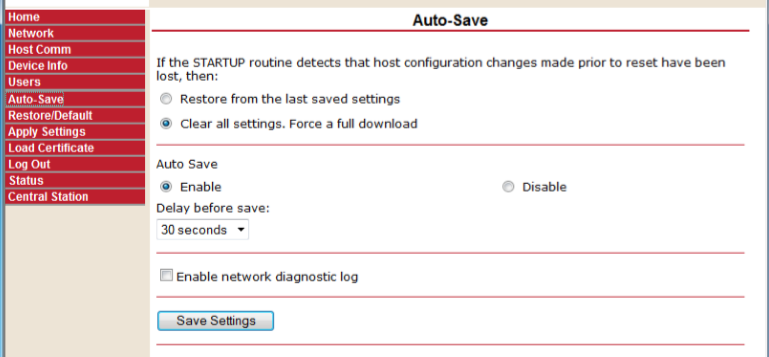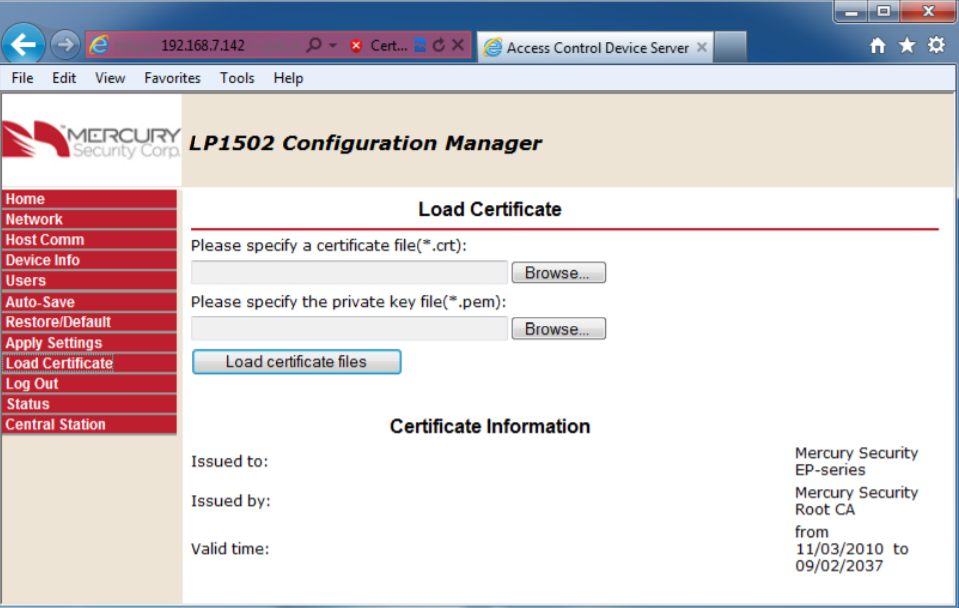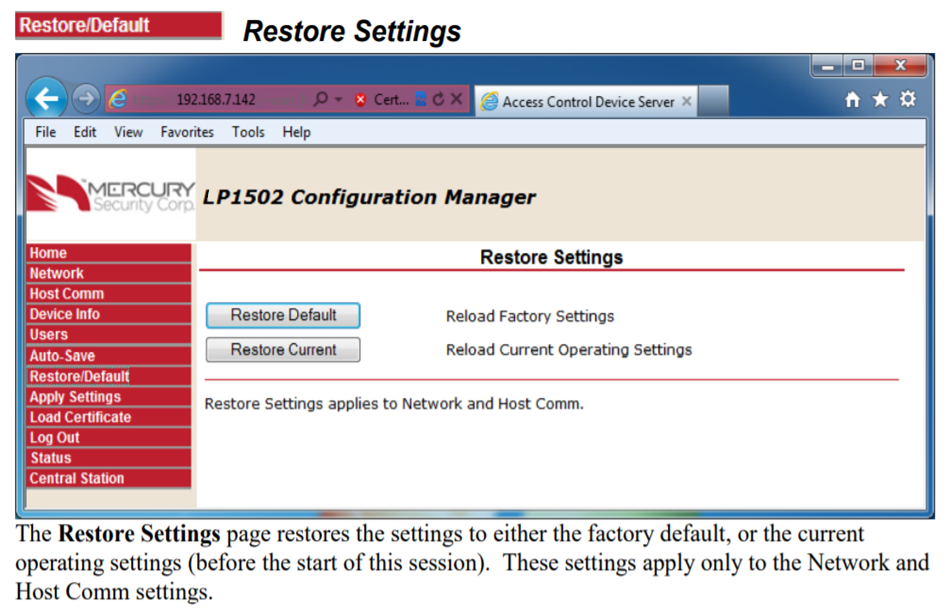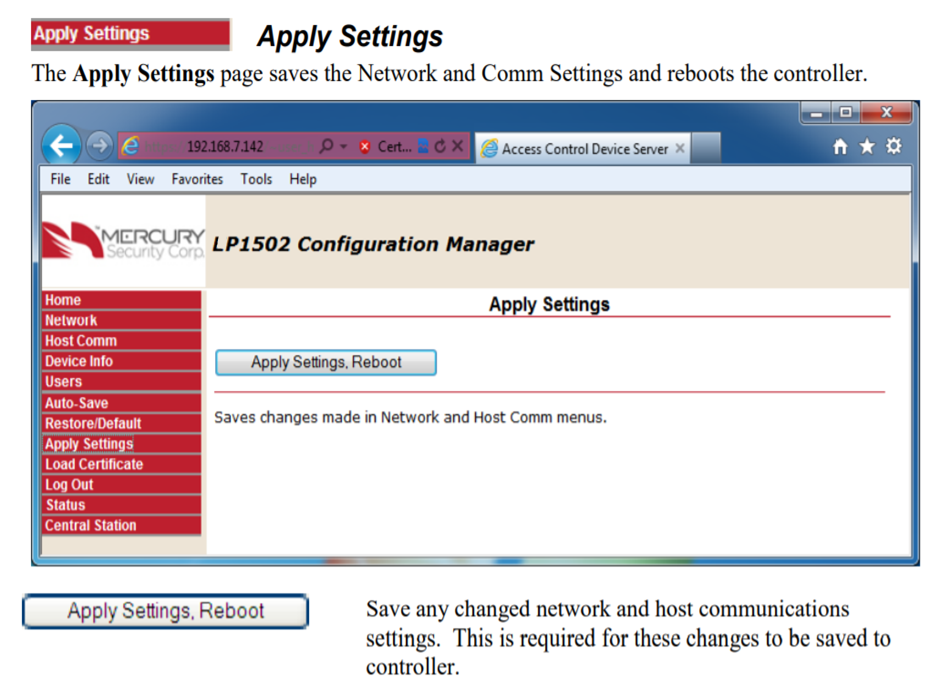Mercury LP Series - Full Reference
1.0 Introduction
This section explains how to setup and configure all controller settings and advanced options. All these settings can be found either by logging into the controller via a web browser or by accessing the controller's 'internal configuration' via the Design Mode feature. Using Doors.NET is the preferred method for setting the basic, standard settings (as it bypasses any browser restrictions or limitations and does not require you to physically be near to the controller). However, for more advanced settings you will need to login to the controller using a web browser.
2.0 Controller Configuration via Web Browser
The web browser interface is a secure connection that is used to configure the LP Series controller. It allows the user to:
- Select the connection method of the Host computer to the controller;
- Configure the IP address (Host Communication address or DHCP name);
- Configure advanced networking options;
- Create and manage user logins;
- Configure Auto-save settings;
- Reload or Reset settings back to default;
- Load Certificates;
- OSDP file transfer;
- View Status;
- Configure security options;
- View device information; and
- Restore settings to factory default.
Note: If you are logging into the controller for the first time using a web browser you should be aware of the fact that there is now an enhanced authentication procedure that requires you to transition DIP switch S1, #1 to the off position. This will give you a 5 minute time window in which you can log into the controller using the default user name (admin) and the default password (password). Once you have logged into the controller you should add a new user name and password so you can bypass this enhanced security procedure in the future.
3.0 Switch Settings on the Controller
The state of the switches on the controller determines the user information used for log on authorization, and communication parameters. By default you would set the DIP switch so that the controller uses factory default communication parameters (this gives the controller a static IP if 192.168.0.251).
Caution: In the factory or OEM default modes, downloaded configuration/database is not saved to flash memory.
| Switch | Definitions | |||
| 1 | 2 | 3 | 4 | |
| OFF | OFF | OFF | OFF | Normal operating mode. |
| ON | X | OFF | OFF | After initialization, enable default User Name (admin) and Password (password). The switch is read on the fly, no need to re-boot. See IT security for additional information. |
| OFF | ON | OFF | OFF | Use factory default communication parameters.(Address: 192.168.0.251 Port: 3001) |
| ON | ON | OFF | OFF | Use OEM default communication parameters. Contact system manufacturer for details. See Bulk erase configuration memory. |
| ON | ON | OFF | OFF | Bulk Erase prompt mode at power up. See Bulk erase configuration memory. |
| X | X | X | ON | Makes the LP2500 report and function like an EP2500. To be used in situations where the host software has not been updated to support the LP series product line. |
- The material provided describes the behavior of the browser with the factory default settings.
- The look and feel of the of the web interface will vary depending on the OEM Settings. Many settings made in the browser can have an OEM specific default. Items that can be customized are in notes.
4.0 Logging Into the Controller
The following steps explain how to log into the controller via Doors.NET. This is the simplest and easiest method as it bypasses any browser security restrictions. You also do not need to be near to the controller and also does not require you to know the controller's programmed IP address.
- Close the hardware setup page.
- Click the Design Mode icon (located in the upper-left).

- When Design Mode is enabled the client will state 'Design Mode' in the title bar.

- Re-open the hardware setup page.
- Right-click the controller and select Internal Controller Configuration.

- Select Network from the Web Page pull-down menu.
- The controller's IP settings will be displayed on the right.
- Set the network method to static.
- Then click the refresh button.
- The appropriate controller settings will then appear on the right-side of the window. Any settings which are not grayed-out can be edited.
- By default a controller is set to a static IP address of 192.168.0.251 - you should set this to your own specific IP address as soon as possible.
5.0 Controller Network Settings
These are the LP controller network settings that can be adjusted:
- Host Name - this is the host description for the controller. By default it displays the controller's MAC address.
- Network Method - The controller IP address can either be static or set to DHCP.
- IP Address - This is the IP address that is assigned to the controller.
- Subnet Mask - The Subnet Mask for the controller.
- Default Gateway - The default Gateway IP address for the controller.
- The DNS Suffix (domain name) may be specified for LP's in the Static IP configuration.
- The DNS server address can be set, in the Static IP configuration. The options are to allow it to be obtained automatically or to use the DNS server address specified.
5.1 Interface 1 & 2 (NIC1 & NIC2)
Interface 1 (NIC1) is the built-in Ethernet interface on the LP. Interface 2 (NIC2) is an optional USB to
Ethernet adapter that is plugged into the LP’s USB (type A) port. USB to Ethernet adapter – Manufacturer:
Plugable. Manufacturer Part Number: USB2-E100.
6.0 Session Settings
- Password Strength - Configures the minimum password strength for the controller.
- Session Timeout - Configures the web session timeout value for this controller.
7.0 Web Connection Settings
- Diagnostic Logging - Select this option to create diagnostic information that will be written to the debug file every 15 minutes (or when the MSC gateway service is restarted.
- Disable Default User - Allows you to disable the default admin/password account.
- Door Forced Filter - Enable/disable filtering of door-forced events for this controller.
- SNMP - Enable/Disable the SNMP setting for this controller
- Web Server - Enables/Disables the Web Server for this controller
- Zeroconf Discover - Enables/Disables the Zeroconf discovery for this controller (used when scanning for NXT-MSC controllers.
8.0 Log into the Controller via Web Browser
This method requires you to know the controller's programmed IP address.
9.0 Host Communications
The Host Communication page configures the communication parameters from the host system
to the LP Series Controller.

The LP1502 and LP2500 support:
- IP Server
- IP Client,
- Serial - RS-232,
- and Serial-Modem communication types.
Notes:
- The LP1501 only supports IP Server and IP Client.
- The LP2500 offers the additional communication options of RS-485 and a serial adapter option to utilize adapters such as the Lantronix Micro 100.
Host Communication Settings
- Data Security: Data security can be set to None, Password/AES, TLS Required, or TLS if Available.
- Port Number: The default port number is 3001. Select the port number the application will use for communication.
- Select connection authorizations: Choose “Allow All” to allow any connection to the specified host port. Choose “Authorized IP Address Required” to restrict connections. If this choice is selected, then enter the authorized IP addresses for connection. (Two addresses are allowed in this mode.)
10.0 Device Information
The Device Info page displays hardware and configuration settings on the controller. This page is refreshed every minute.

11.0 User Accounts
The User Accounts page manages user definitions for the web interface. Users may be added, deleted or modified from this web page. Ten users may be authorized.
- EDIT - Displays the account information for the currently selected user.
- DELETE - Deletes any users that have been selected.
- NEW USER - Displays the user account input form to create a new user.
Password Strength
- The password strength in the LP Web server can be set to Low, Medium, or High.
- Low Password Strength – minimum of 6 characters
- Medium Password Strength – minimum of 6 characters and passes two of the password strength tests
High Password Strength – minimum of 8 characters, passes three of the password strength tests,
and password not based on user name
The following strong password requirements are based on Microsoft guidelines for creating
strong passwords.
Password Strength Tests – contains characters from any of the following categories:
- Uppercase alphabet characters (A–Z)
- Lowercase alphabet characters (a–z)
- Arabic numerals (0–9)
- Symbol characters (` ! $ ? ^ * ( ) _ - + = { [ } ] : ; @ ' ~ # | < , > . /)
Example:
The password strength is set to “Medium”, the password Gertrude is valid because it has more than 6 characters and is a combination of upper and lower case.
The password strength is set to “High”, the password Gertrude8 is valid as long as the user
name is not Gertrude.
12.0 Session Timer
The session timer specifies the period of inactivity before the user is logged out. The inactivity
timer can be between 5 and 60 minutes.
Note: OEM Settings can change the default settings for Session Timer.
![]() Saves any changes made to the user page other than changes made to the actual users.
Saves any changes made to the user page other than changes made to the actual users.
Special Features
See the Special Features section at the end of this document for the additional settings that are only enabled when Switch 1 is enabled.
13.0 Auto-Save Settings
The Auto Save page configures Auto-save behavior and determines how the controller reacts on startup if host configuration changes have been lost.

Select Restore from the last saved settings to restore from the save point at power up, or from the
re-boot button on the controller. Select Clear all settings. Force a full download. To force a
controller reload at power-up.
- Enabling Auto-save configures the controller to automatically save settings for configuration changes.
- Disabling Auto-save means that configuration changes are not automatically saved. Configuration can be manually saved by command 211, Dual Port Control
- Auto-save delay specifies how much time to wait after a host configuration change before starting the save. The timer can be specified between 30 seconds and 30 minutes.
- Enable Network Diagnostic Log causes diagnostic information to be written to the debug file every 15 minutes, when debug is enabled.
>> OEM Settings determine the default setting for restoring configuration after a power up, or
re-boot, and for specifying the default auto-save delay timer.
 You must click on “Save Settings” for changes to be loaded to the controller.
You must click on “Save Settings” for changes to be loaded to the controller.
14.0 Load Certificate
The Load Certificate page will allow the certificates loaded by Mercury at the factory to be replaced by unique custom certificates.

The browse buttons can be used to select the related files that will be loaded to the LP once the “Load certificate files” button is pressed.
The LP series controllers allow for a maximum 4096-bit RSA key encryption and SHA-384.
Certificate Types
- The .crt file is the certificate file.
- The .pem file is the Private Key file.
Note:
- Settings are not permanently saved in the device until saved on the “Apply Settings” web page
- The Certificate Information section of the page lists information about the currently loaded certificates.
- OEM Settings can determine whether the “Load certificate files” button is enabled or not.
15.0 Restore Settings

The Restore Settings page restores the settings to either the factory default, or the current operating settings (before the start of this session). These settings apply only to the Network and Host Comm settings.
 Restore the settings to factory default (192.168.0.251; IP Server; Static IP configuration).
Restore the settings to factory default (192.168.0.251; IP Server; Static IP configuration).
 Restore the settings to the settings at the start of the session.
Restore the settings to the settings at the start of the session.
16.0 Apply Settings
The Apply Settings page saves the Network and Comm Settings and reboots the controller.

APPLY SETTINGS, REBOOT - Save any changed network and host communications settings. This is required for these changes to be saved to controller.
17.0 Log Out
The Log Out link will end the session on the controller and the following page should appear.
Related Articles
EP/LP/MP Internal Configuration Reference Guide
1.0 Introduction Doors.NET allows you to access the EP, LP and MP controller's Internal Configuration and advanced settings when using the Design Mode feature. The steps apply to all Mercury (MSC) controller types: MP1501, MP1502, MP2500 and MP4502. ...Mercury EP Series - Full Reference
1.0 Introduction This section explains how to setup and configure all controller settings and advanced options. These settings can be found either by logging into the controller via a web browser or by accessing the controller's 'internal ...MP Series Full Setup and Configuration Guide
1.0 Introduction This section explains how to setup and configure all controller settings and advanced options. All these settings can be found either by logging into the controller via a web browser or by accessing the controller's 'internal ...Mercury Security Firmware Vulnerability
Notice Regarding Mercury Security Firmware Vulnerability Jun 22, 2022 Mercury Security has been informed of a firmware security issue affecting the following hardware: LP1501, LP1502, LP2500, LP4502, and EP4502. This issue makes it possible for a ...Mercury - Hardware Overview
EP Series Controllers LP Series Controllers MP Series Controllers Mercury I/O and Door Modules Note: Doors. NET supports the Series 2 modules (green PCBs), the Series 3 modules (red PCBs) and the Series 4 modules (black PCBs). All series of modules ...